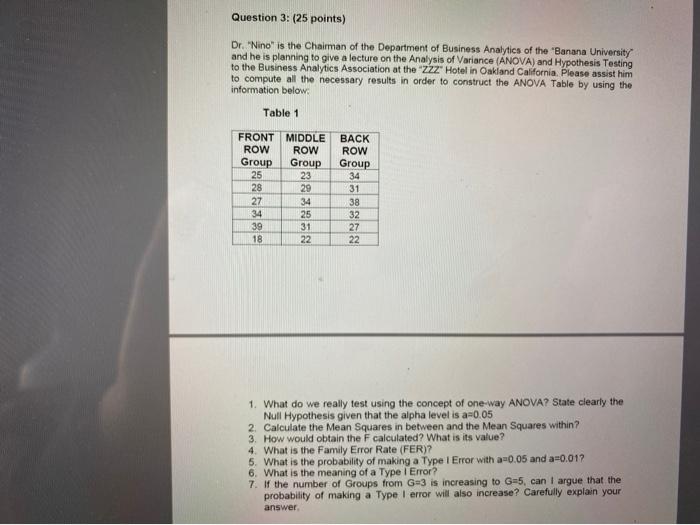Question 3: (25 points) Dr. "Nino" is the Chairman of the Department of Business Analytics of the Banana University and he is planning to give a lecture on the Analysis of Variance (ANOVA) and Hypothesis Testing to the Business Analytics Association at the "Zzz Hotel in Oakland California. Please assist him to compute all the necessary results in order to construct the ANOVA Table by using the information below Table 1 FRONT MIDDLE ROW ROW Group Group 25 23 28 29 27 34 34 25 39 31 18 22 BACK ROW Group 34 31 38 32 27 22 1. What do we really test using the concept of one-way ANOVA? State clearly the Null Hypothesis given that the alpha level is a 0.05 2. Calculate the Mean Squares in between and the Mean Squares within? 3. How would obtain the F calculated? What is its value? 4. What is the Family Error Rate (FER)? 5. What is the probability of making a Type 1 Error with a 0.05 and a 0.017 6. What is the meaning of a Type 1 Error? 7. If the number of Groups from G3 is increasing to G#5, can I argue that the probability of making a Type 1 error will also increase? Carefully explain your answer Question 3: (25 points) Dr. "Nino" is the Chairman of the Department of Business Analytics of the Banana University and he is planning to give a lecture on the Analysis of Variance (ANOVA) and Hypothesis Testing to the Business Analytics Association at the "Zzz Hotel in Oakland California. Please assist him to compute all the necessary results in order to construct the ANOVA Table by using the information below Table 1 FRONT MIDDLE ROW ROW Group Group 25 23 28 29 27 34 34 25 39 31 18 22 BACK ROW Group 34 31 38 32 27 22 1. What do we really test using the concept of one-way ANOVA? State clearly the Null Hypothesis given that the alpha level is a 0.05 2. Calculate the Mean Squares in between and the Mean Squares within? 3. How would obtain the F calculated? What is its value? 4. What is the Family Error Rate (FER)? 5. What is the probability of making a Type 1 Error with a 0.05 and a 0.017 6. What is the meaning of a Type 1 Error? 7. If the number of Groups from G3 is increasing to G#5, can I argue that the probability of making a Type 1 error will also increase? Carefully explain your







